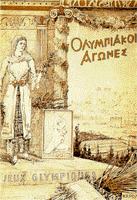HISTORY OF THE MODERN OLYMPICS
Athens, Greece, 1896
 |
| Olympic posters from the Archives, Olympic Museum Lausanne, from the book The Olympic Spirit, published by Tehabi Books |
The track-and-field events were held at the Panathenaic Stadium. The stadium, originally built in 330 BC, had essentially been in ruins before the 1896 Olympics, but through the direction and financial aid of Georgios Averoff, a wealthy Greek architect, it was restored with white marble. The track had an unusually elongated shape with such sharp turns that runners were forced to slow down considerably in order to stay in their lanes. The track-and-field competition was dominated by American runners, who won 9 of the 12 events. The swimming events were held in the cold currents of the Bay of Zea. Two of the four swimming races were won by Alfréd Hajós of Hungary. Paul Masson of France won three of the six cycling events.
The 1896 Olympics featured the first marathon. The race, conceived by Frenchman Michel Bréal, followed the legendary route of Pheidippides, a trained runner who was believed to have been sent from the town of Marathon to Athens to announce the defeat of an invading army in 490 BC. The race became the highlight of the games and was won by Spyridon Louis, a Greek whose victory earned him the lasting admiration of his nation.
Introduction * Early History * Revival of the Olympics * Organization of the Modern Games